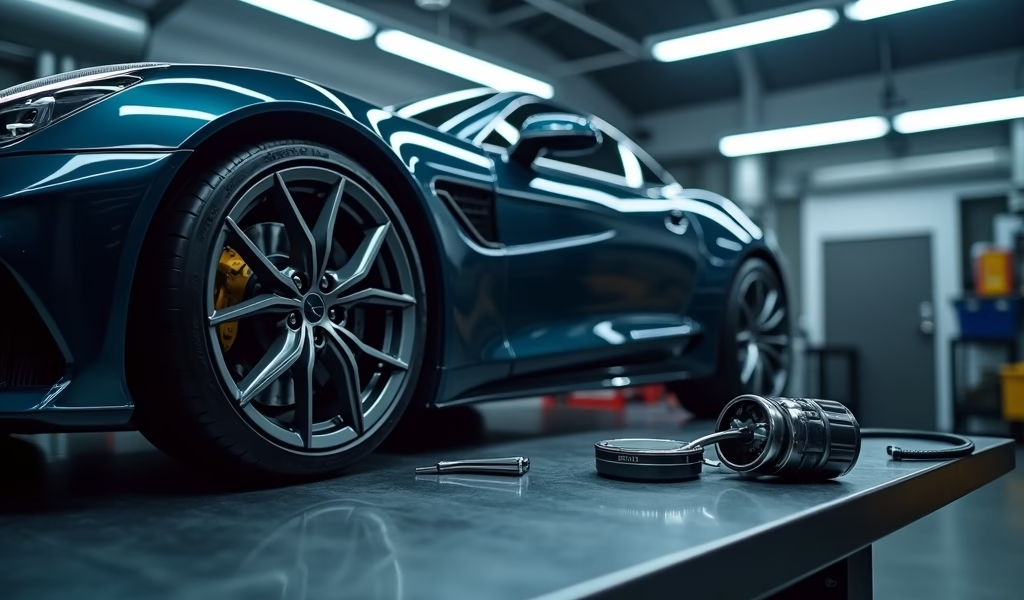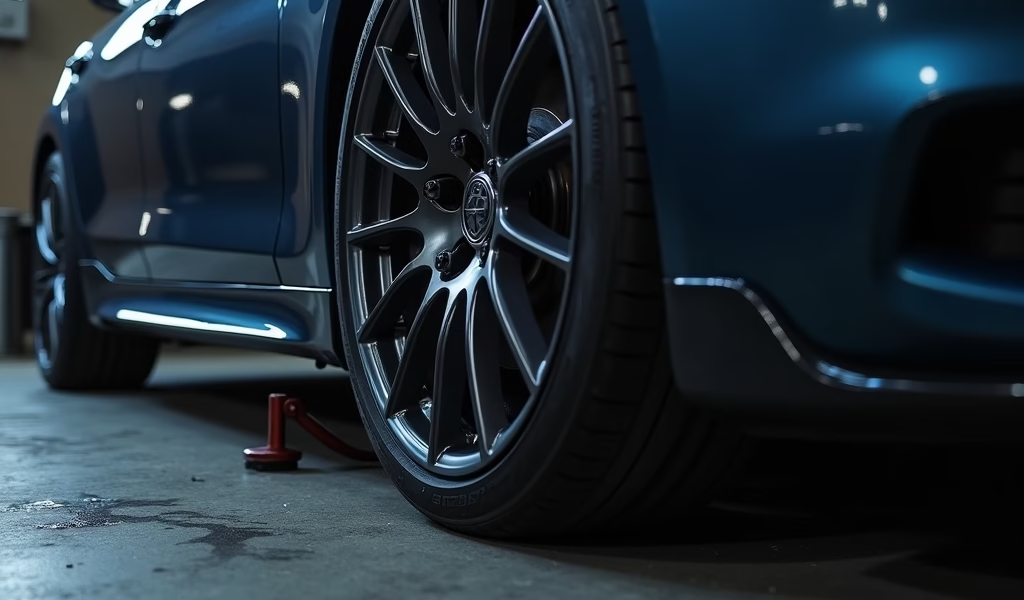Overview
Cast wheel porosity testing is vital for detecting tiny voids in aluminum wheels that could compromise structural integrity, with methods ranging from visual inspection to X-ray testing. The article covers porosity prevention strategies, testing procedures, results interpretation, and emphasizes that while some porosity is inevitable, proper testing is crucial for safety as it identifies dangerous defects before wheels reach vehicles.
Table of Contents
- What is Cast Wheel Porosity?
- Why Porosity Testing Matters
- Common Testing Methods
- Expert Tips for Effective Porosity Testing
- Preventing Porosity in Wheel Casting
- Interpreting Test Results
- Conclusion
- Frequently Asked Questions
What is Cast Wheel Porosity?
If you’ve ever peered closely at a cast aluminum wheel and noticed tiny pinholes or dark spots, you’ve seen porosity in action. As a mechanic who’s inspected thousands of wheels, I can tell you these seemingly innocent imperfections are actually worth your attention.
Cast wheel porosity refers to small voids or cavities that form within the metal during the casting process. Think of them as tiny air bubbles trapped in the aluminum alloy as it solidifies. These microscopic holes might seem harmless, but they can compromise the structural integrity of your wheels if left unchecked.
Porosity typically occurs in two main forms:
- Gas porosity: Caused by hydrogen gas that dissolves in the molten aluminum and forms bubbles as the metal cools
- Shrinkage porosity: Occurs when areas of the wheel cool at different rates, causing the metal to pull apart and create voids
These imperfections vary in size from microscopic pinholes to larger cavities that might be visible to the naked eye after machining. The location of these voids matters too – porosity in high-stress areas like the spoke-to-rim transition can be particularly problematic.
While most wheels have some degree of porosity (it’s nearly impossible to eliminate completely), excessive or poorly-located porosity can lead to serious issues down the road. That’s where proper testing comes in – it helps identify wheels with dangerous defect levels before they ever make it onto a vehicle.
Why Porosity Testing Matters
Let’s be real – nobody wants to think about wheel failure while cruising down the highway at 70 mph. As someone who’s witnessed the aftermath of wheel failures, I can’t stress enough why porosity testing is crucial.
First and foremost, it’s about safety. Wheels bear incredible loads and stresses during normal driving. When you hit a pothole or make a hard turn, those forces concentrate at certain points in your wheel. If those high-stress areas contain porosity defects, cracks can develop over time, potentially leading to catastrophic failure.
Beyond the obvious safety concerns, porosity can cause several other headaches:
- Air leaks in tubeless tire applications, leading to constant pressure loss
- Corrosion issues as moisture infiltrates the porous areas
- Cosmetic problems when porosity becomes visible after painting or chrome plating
- Warranty claims and customer dissatisfaction
For manufacturers, consistent porosity testing helps identify process issues before they create massive batches of defective wheels. This saves money, maintains quality standards, and protects brand reputation. Industry standards from ASTM International provide guidelines for acceptable porosity levels, giving manufacturers clear benchmarks to meet.
For wheel shops and mechanics, understanding porosity helps when assessing used or damaged wheels. A wheel that’s been repaired or shows signs of impact should be carefully checked for porosity-related cracks, especially if you’re working with wheels of varying rim widths that might distribute forces differently.
The bottom line? Thorough porosity testing means safer wheels, fewer warranty claims, and peace of mind for everyone involved.

Common Testing Methods
When it comes to sniffing out those sneaky porosity problems, we’ve got a whole toolkit of testing methods. Each has its strengths, and in my 15+ years in the field, I’ve found that combining approaches usually gives the best results.
Let’s walk through the main testing methods you’ll encounter:
Visual Inspection
Don’t underestimate the power of a trained eye! Visual inspection is our first line of defense, especially after machining operations that might reveal subsurface defects.
The process is straightforward: a quality inspector examines the wheel under good lighting, looking for telltale pinhole defects or dark spots. This works best on machined, unpainted surfaces where porosity is more visible. While simple, this method catches many obvious issues before more expensive testing is needed.
Liquid Penetrant Testing
This method is like giving your wheels a temporary tattoo that reveals hidden flaws. Here’s how it works:
- The wheel is thoroughly cleaned
- A colored or fluorescent dye is applied to the surface
- The dye seeps into any surface-breaking pores
- Excess penetrant is removed
- A developer is applied, drawing the penetrant out of defects
- Under normal or UV light, porosity appears as colored indications
Liquid penetrant testing is relatively inexpensive and can detect very small surface defects. The downside? It only finds porosity that breaks the surface, missing internal voids that haven’t been exposed.
Pressure Testing
For wheels designed to be used with tubeless tires, pressure testing is essential. We seal the wheel, pressurize it (usually with air or water), and watch for bubbles or pressure drops that indicate leaks through porous areas.
This practical test directly evaluates whether the wheel will hold air, which is obviously important! However, it won’t detect porosity that doesn’t create a complete path through the metal.
X-Ray Testing
Now we’re getting fancy! X-ray inspection passes radiation through the wheel and captures an image on film or digital detectors. Porosity shows up as darker spots on the image, allowing us to see internal defects that other methods might miss.
While incredibly effective, X-ray testing requires expensive equipment, trained operators, and safety precautions due to the radiation involved. Most shops reserve this method for high-end wheels or random batch sampling rather than 100% testing.
Ultrasonic Testing
Using high-frequency sound waves, ultrasonic testing can detect inconsistencies within the metal. The principle is similar to medical ultrasounds – sound waves reflect differently from solid metal versus porous areas.
This non-destructive method provides immediate results and can find subsurface defects. The challenge is that it requires skilled technicians and can be difficult to perform on complex wheel geometries.
In my experience, the most effective approach combines multiple methods. For example, many manufacturers start with visual inspection, follow with liquid penetrant on suspicious areas, and periodically sample with X-ray to verify internal quality. When determining wheel diameter measurements, these tests become especially important for ensuring structural integrity across the entire wheel.
Expert Tips for Effective Porosity Testing
After years of hands-on experience testing thousands of wheels, I’ve developed some practical tips that can make your porosity testing more effective. These aren’t just theoretical – they’re the same approaches I use in my shop every day.
Optimize Your Lighting
Good lighting makes all the difference in visual inspection. I recommend using adjustable LED lights that you can position at low angles to create shadows that highlight surface irregularities. For liquid penetrant testing, invest in a good UV light with the right wavelength (usually around 365nm) and ensure you’re working in a dimly lit area for maximum contrast.
One trick I’ve found helpful: rotate the wheel slowly while keeping your light source stationary. This creates moving shadows that can reveal subtle defects that might otherwise go unnoticed.
Establish a Consistent Process
Consistency is key to reliable results. Create a standardized testing procedure that includes:
- Specific cleaning methods before testing (especially important for penetrant testing)
- Predetermined inspection points and sequences
- Standard dwell times for penetrants
- Clear acceptance/rejection criteria
- Documentation requirements
Write these procedures down and train everyone involved. This eliminates the “it depends who’s testing” syndrome that can plague quality control departments.
Focus on Critical Areas
Not all porosity is equally problematic. Pay special attention to these high-stress areas:
- Spoke-to-rim transitions
- Lug hole regions
- Valve stem holes
- Any area with significant thickness transitions
Porosity in these zones poses much greater risks than similar defects in low-stress areas. When checking wheels that will undergo weight balancing procedures, be especially vigilant about porosity near balancing weight attachment points.
Use Proper Surface Preparation
For penetrant testing to work effectively, surfaces must be impeccably clean. Any oils, machining fluids, or debris can mask defects. I recommend:
- Solvent cleaning followed by thorough drying
- Avoiding touching cleaned surfaces with bare hands (oils from your skin can interfere)
- Using lint-free cloths for wiping
Take extra care with used wheels – brake dust and road grime can be stubborn and hide potential issues.
Document Everything
Keep detailed records of your testing results, including:
- Date and time of testing
- Testing method used
- Specific wheels tested (batch numbers, serial numbers)
- Photos of any defects found
- Action taken for rejected parts
This documentation isn’t just bureaucracy – it helps identify patterns over time and can be invaluable if warranty issues arise later.
Invest in Training
The best equipment in the world is useless without properly trained operators. Make sure your team understands not just the “how” but the “why” of porosity testing. Professional certification programs from organizations like the American Society for Nondestructive Testing can provide valuable credentials and knowledge.
Remember, effective testing isn’t about finding every microscopic void – it’s about confidently identifying wheels with potentially dangerous defect levels. With these practical tips, you’ll be well on your way to more reliable testing results.
Preventing Porosity in Wheel Casting
While testing catches problems after they occur, the real goal should be preventing porosity in the first place. As the old saying goes, an ounce of prevention is worth a pound of cure – especially true when we’re talking about wheel casting!
Having worked closely with several wheel manufacturers, I’ve seen firsthand how the following preventive measures can dramatically reduce porosity issues:
Control Your Metal Quality
It all starts with what goes into the furnace. High-quality aluminum alloy with controlled hydrogen content sets the foundation for porosity-free castings. Many manufacturers now use hydrogen analyzers to test metal before casting and establish strict acceptance limits.
Equally important is proper metal handling. Even the best alloy can absorb hydrogen from the atmosphere or from contaminated tools. Keep tools clean, minimize transfer operations, and keep molten metal covered whenever possible.
Implement Effective Degassing
Degassing is the process of removing dissolved gases (primarily hydrogen) from molten aluminum before casting. Modern degassing methods include:
- Rotary impeller degassing with nitrogen or argon
- Tablet flux degassing (though less effective than gas purging)
- Vacuum degassing for critical applications
Proper degassing can reduce hydrogen levels by 50-80%, dramatically decreasing gas porosity in the finished wheel.
Optimize Mold Design
Smart mold design plays a huge role in preventing shrinkage porosity. Work with experienced pattern makers who understand:
- Proper gating system design to minimize turbulence
- Strategic riser placement to feed shrinkage-prone areas
- Chill placement to control solidification patterns
- Venting to allow gases to escape
Computer simulation software has revolutionized this field, allowing designers to predict and address potential shrinkage issues before cutting the first tool.
Control Process Parameters
Consistent process control separates the best manufacturers from the rest. Key parameters to monitor include:
- Pouring temperature (too hot increases hydrogen absorption)
- Mold temperature (affects solidification rate)
- Fill rate (too fast creates turbulence and oxide inclusions)
- Cooling rate (affects microstructure and shrinkage)
Modern foundries use sophisticated data logging systems to track these parameters for every casting, allowing them to correlate process variations with quality results.
Address Environmental Factors
The foundry environment itself can contribute to porosity issues. Humidity is a major culprit, as water vapor contains hydrogen that can be absorbed by molten aluminum. Consider:
- Climate control in critical areas of the foundry
- Dehumidification during wet seasons
- Covering metal and tools when not in use
- Proper storage of raw materials
I’ve seen foundries reduce their porosity rates significantly just by implementing better humidity control during summer months.
Remember, prevention is an ongoing process. Continuous monitoring, coupled with a commitment to quality, is the key to consistently producing low-porosity wheels.

Interpreting Test Results
Finding porosity is one thing – knowing what to do about it is another! In my years training quality inspectors, I’ve noticed this is where many testing programs fall short. Let’s demystify the interpretation process.
Understanding Acceptance Standards
First, you need clear criteria for what constitutes an acceptable versus rejectable defect. Most manufacturers follow standards based on:
- Maximum allowable pore size (typically measured in mm)
- Maximum number of pores per square inch
- Minimum acceptable distance between pores
- Location-specific requirements (stricter limits in critical areas)
These standards often vary by wheel application. A performance wheel for a sports car will have tighter requirements than an economy car’s wheel, for instance.
Evaluating Defect Severity
When you find porosity, assess these key factors:
- Size: Larger pores create greater stress concentration
- Shape: Irregular, sharp-edged voids are more concerning than round ones
- Location: Porosity in high-stress areas is more problematic
- Clustering: Multiple pores close together can act as a single larger defect
- Depth: Surface pores may be cosmetic issues, while deep pores affect structural integrity
In my experience, location is often the most critical factor. A small pore in a spoke-to-rim transition can be more dangerous than a larger one in a low-stress area.
Common Interpretation Challenges
Even experienced inspectors encounter tricky situations. Here are some common challenges and how to handle them:
- False positives: Tool marks or surface texture can sometimes look like porosity. When in doubt, examine from multiple angles or use a different testing method to confirm.
- Borderline cases: When a defect is right at the acceptance limit, err on the side of caution. I always say, “If you’re debating whether it passes, it probably doesn’t.”
- Distinguishing types: Gas porosity (typically round) versus shrinkage porosity (usually irregular) can require different corrective actions in manufacturing.
Documentation Best Practices
Proper documentation of test results serves multiple purposes – quality tracking, process improvement, and legal protection. Include:
- Clear photos of defects with size reference
- Precise location descriptions (a diagram helps)
- Measurement data where applicable
- Decision rationale for borderline cases
Digital documentation systems make this much easier than paper records and allow for better trend analysis over time.
Using Results for Process Improvement
The real value of testing comes when you use the results to drive improvements. Look for patterns like:
- Recurring porosity in specific locations (may indicate mold design issues)
- Sudden increases in defect rates (process parameter shift)
- Seasonal variations (environmental factors)
- Differences between shifts or operators (training or procedure issues)
Share these insights with the production team – they’re gold for continuous improvement efforts.
Conclusion
Cast wheel porosity testing isn’t just a quality control checkbox – it’s a crucial safety measure that protects drivers, passengers, and manufacturers alike. As we’ve explored throughout this article, effective testing combines the right methods, proper training, and consistent processes to catch potentially dangerous defects before wheels hit the road.
While no casting process can eliminate porosity completely, a comprehensive approach that includes both prevention and detection can minimize risks substantially. The key is understanding that different testing methods have different strengths, and combining them strategically provides the most complete picture of wheel quality.
Remember these key takeaways:
- Use multiple testing methods for comprehensive coverage
- Focus extra attention on high-stress areas of the wheel
- Establish clear acceptance criteria based on industry standards
- Invest in proper training for all testing personnel
- Document results thoroughly and use them for continuous improvement
Whether you’re a quality inspector at a wheel factory, a mechanic evaluating used wheels, or a consumer wanting to understand what goes into making safe wheels, I hope this guide has provided valuable insights into the world of porosity testing.
Safe wheels make for safe roads, and thorough testing is what stands between potentially dangerous defects and the driving public. That’s something worth investing in!
Frequently Asked Questions
How serious is wheel porosity?
Wheel porosity ranges from harmless cosmetic issues to serious safety concerns, depending on size, location, and quantity. Porosity in high-stress areas like spoke-to-rim transitions can lead to cracks and potential wheel failure under load.
Can porosity in wheels be repaired?
Minor surface porosity can sometimes be addressed with specialized fillers for cosmetic purposes, but structural porosity cannot be reliably repaired. Wheels with structural porosity should be rejected and recycled.
How can I tell if my wheels have porosity issues?
Visual inspection might reveal pinholes on machined surfaces, while air leaks around the rim area can indicate through-porosity. Professional testing methods like liquid penetrant or x-ray inspection provide more definitive detection.
Are cast wheels with some porosity still safe to use?
Minor porosity in non-critical areas is generally acceptable and present in most cast wheels. Safety concerns arise when porosity exceeds manufacturer specifications or appears in high-stress areas.
Are forged wheels less prone to porosity than cast wheels?
Yes, forged wheels typically have significantly less porosity than cast wheels. The forging process compresses the metal under high pressure, eliminating voids and creating a denser, stronger structure.

